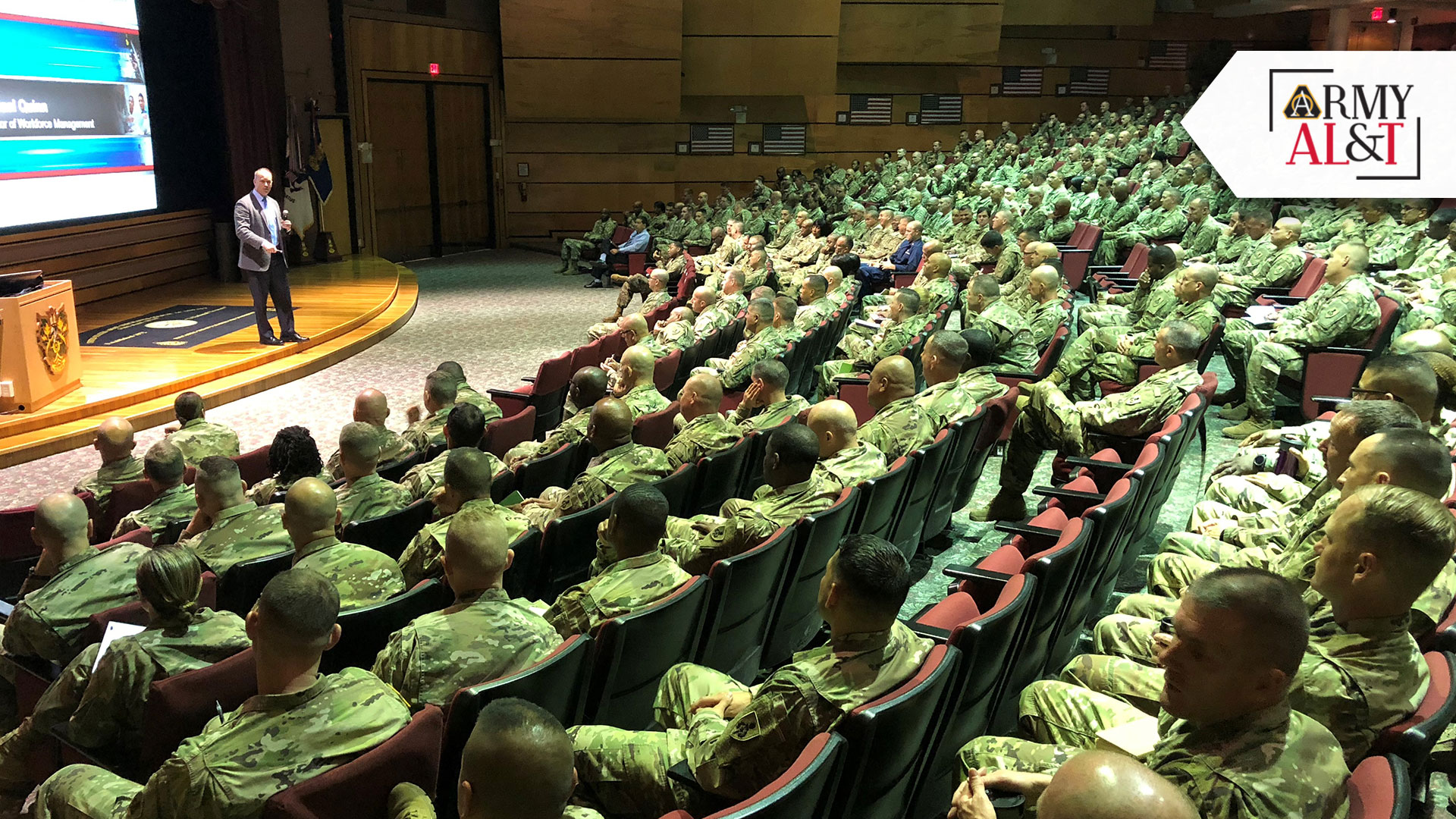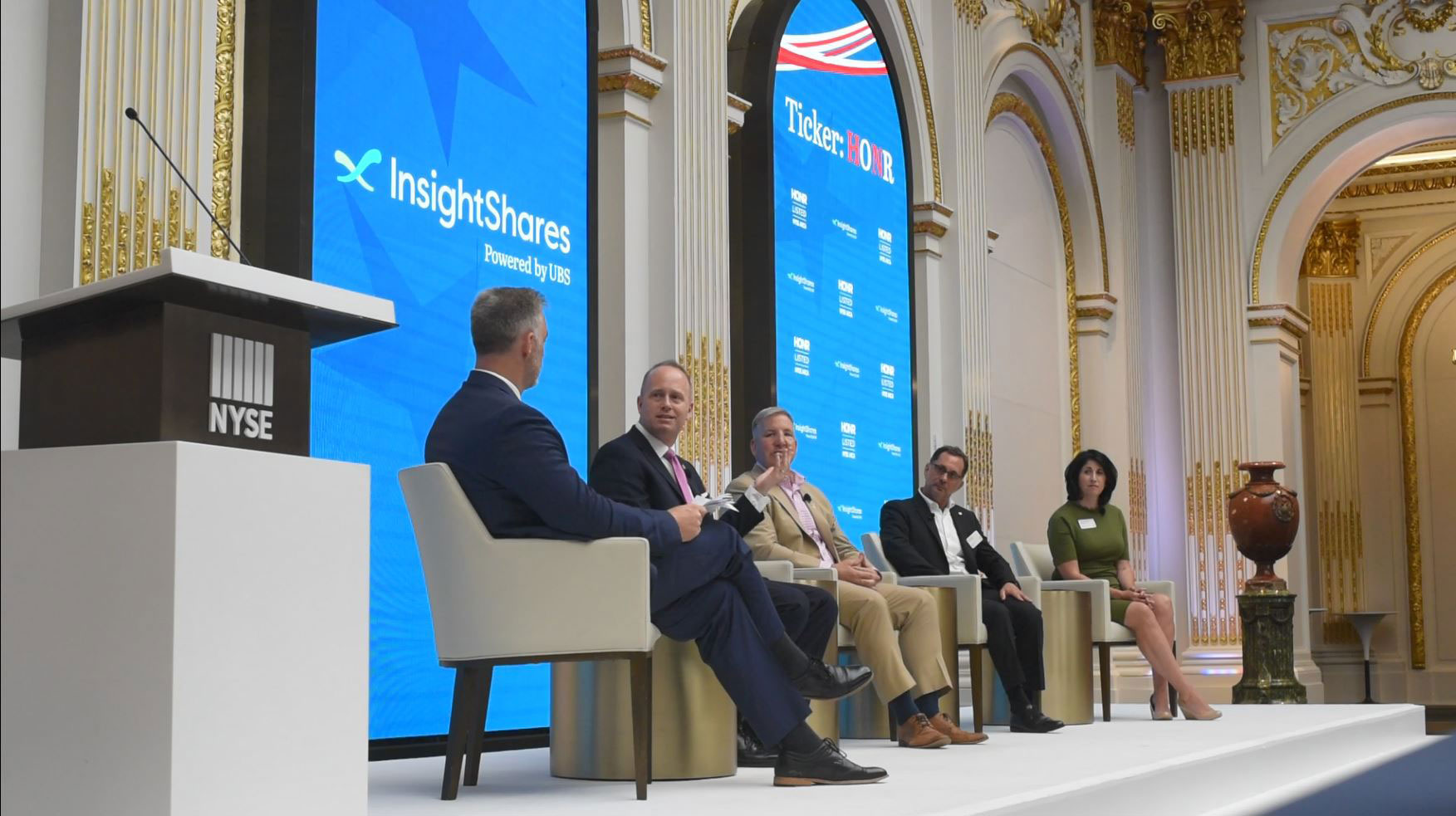
COMMAND PERFORMANCE: Quinn speaks about the transition from the military and how LinkedIn can be an important tool at the main auditorium of the NCO Leadership Center of Excellence and the United States Army Sergeants Major Academy in April 2018 at Fort Bliss, Texas. (Photo courtesy of Michael Quinn)
For Michael Quinn, retiring from the Army was ‘the most difficult year of my life,’ struggling to find the right job. But eventually, he created his own job helping others find their next steps.
by Ellen Summey
If you spend much time on LinkedIn, chances are you’ve heard of Michael Quinn. The two-time LinkedIn “Top Voice” and member of the Forbes Coaches Council has more than 300,000 followers; his posts about military separation and veteran employment are viewed by more than a million people every month. For military service members on LinkedIn—Quinn’s key demographic—you can’t swing a reflective PT belt without hitting one of his posts. So, how did Quinn go from active-duty Soldier to LinkedIn leader? It all started with a misguided retirement plan.
“I was a military intelligence sergeant major, planning on doing 30 years. I loved everything I was doing. I was at 23 years, there on Fort Belvoir [Virginia], where I was the G-3 (operations and training) sergeant major for the U.S. Army Intelligence and Security Command. The next list of assignments was coming out, and when I brought that list home to my spouse at the time, she said, ‘Yeah, I’m not moving.’ ” Quinn and his family had moved seven times in nine years, “a typical military story,” as he put it. “She gave up her career when we got married, she couldn’t get a job overseas, she couldn’t get a job at El Paso when we moved there for the Sergeants Major Academy for a year, and we finally got back to the D.C. area. We were eight minutes from her family, we had two small kids, we had a house, and she finally had a good job, and she said, ‘I’ll see you when you get back.’ And so, I went from having seven more years, at least, in the Army, to ‘I’m getting out in a year.’ ”
ADJUSTING FIRE
Quinn prepared for his retirement with the dedication you would expect of a career Soldier. He started planning and applying nearly a year in advance, he attended all the Army transition workshops, and he set his sights on high-paying jobs in industry. “You know, I’m pretty confident in my abilities. I communicate well, I write well, I made it to sergeant major, I was in military intelligence with a TS-SCI clearance, in the D.C. area. I thought it was going to be a breeze. Like I could just walk out, say ‘I’m available,’ and six figures would be thrown at me.”
He can laugh about it now, but he even applied for a job as director of security for the National Football League. Quinn’s transition in 2017 was not what he imagined it would be. “I went to my first job fair, prepped to the T as far as I knew. I had a two-page resume that I wrote over a period of weeks and put a lot of effort into, tried out my elevator pitch, wore my best suit, had business cards, everything. I did the research on all the companies there, and over a period of six hours, I watched everyone around me get asked to interview, except for me.”
That experience was a wakeup call for Quinn, and was the first spark of what has since become a thriving business. “I just dove in to LinkedIn. It just made sense to me,” he said. “I started reaching out and connecting with people in all different fields, all different companies, all over the country, and just asking, ‘Hey, what is your career field like? What’s your job like? What do you do every day?’ ” He was on a mission to market himself in a more effective way. “I started posting content, sharing things that I was doing, thoughts on leadership, writing articles, writing posts. And then I realized, well heck, I was one of the only people from the military on LinkedIn at the time.” So he did what a good leader does—he shared his knowledge and skills with his team. He started teaching other service members, first in his own unit and then others, how to share contacts, how to network, how to perform job searches, “and it just kind of steamrolled.”

TAKING STOCK: Quinn, second from left, speaks at the New York Stock Exchange in 2018. (Photo courtesy of Michael Quinn)
NETWORK IN ACTION
As his retirement date approached, Quinn kept expanding his network and sharing his insights (now under the hashtag #Quinnsights), and then something unexpected happened. “One month before I retired, I was hired as the director of workforce management at a small, federal IT company. I literally was introduced to the CEO from another CEO I met via LinkedIn. I went in to just have coffee and he made me a job offer on the spot. He created a director-level role for me.” Quinn worked there for about a year, learning everything he could learn in the role, and when he felt it was time to find the next opportunity, “I started activating my network again.” Within four months, he landed an executive role at Big Four accounting firm Ernst & Young (EY)—a feat made no less impressive by his self-professed lack of qualifications.
“I ran People Advisory Services on the Army account for a period of time, and I led our change management training and communications work stream, on what was the government and public sector’s largest account, which was Army Audit Readiness,” he said. “I mean, literally, I have a Bachelor of Science in liberal arts from Excelsior College. I have no PMP [Project Management Professional], I mean, I don’t meet any of the qualifications on paper. I didn’t look like other senior managers on paper, but because I got on LinkedIn, because I had a network, because I got face-to-face and spoke with partners, they saw talent. They saw that bringing me to their team was going to bring value, and they told recruiting to hire me.”
MEETING A NEED
DOD offers a transition assistance program for active-duty service members, called DOD SkillBridge. It allows service members within their last 180 days of service to work directly for outside employers in training, internship or apprenticeship positions, while retaining their military pay and benefits, for up to six months. “I found out late in my transition about the DOD SkillBridge program, and it was too late for me to use it,” Quinn said. As word got out about the program, he started hearing from friends who had applied but weren’t placed in internships. One cohort “had 30 credible internships and 90 applicants, so 60 people did not get placed, and they had their hearts set on an internship.” When they reached out, Quinn told them to take matters into their own hands. “I said, ‘Well, start your own. Find a company that will accept you as an intern, file the paperwork, and you should be golden.’ And they looked at me like I was crazy.”
It was then he realized, “they don’t have connections at companies. They don’t know how to explain the Fair Labor Standards Act, and how SkillBridge is not an unpaid internship.” And then there is all the paperwork, the legal review and more. “That was where HireMilitary was started,” in August 2018, Quinn said. Today, HireMilitary is a service that links service members with vetted employers for the DOD SkillBridge program through its own web-based platform. It has grown to include direct job placement for veterans and military spouses as well, and now employs a team of 20 people around the U.S. “We really exploded,” Quinn said.
Meanwhile, he was still holding down his day job at EY. He knew he had a choice to make. “It came to a point where I left the company, because I figured I could be a better partner to the firm, owning a service-disabled veteran-owned small business, than competing for them as a partner in a large firm like EY.”

MILITARY INTERNS: The LinkedIn page for HireMilitary, a service that links service members with vetted employers for the DOD SkillBridge program.
A NEW FOCUS
Since December 2020, Quinn has been focused on his blossoming company—and it shows. He now has three distinct business units under Tenova LLC, the parent company of HireMilitary. “We’ve got HireMilitary, which now does both internships and direct placement. We’ve started taking on select companies [for direct job placement] because we want to focus on making sure they’re the right fit and focus on retention. We want to make sure we place people in roles that are great for them and the company. That’s for service members, veterans and military spouses.”
Quinn and his team also created a Digital Networking Professional Program, which is a certification program that teaches people how to use LinkedIn effectively. “We created the program because there were, almost overnight, tons of LinkedIn coaches, LinkedIn ‘optimizers,’ LinkedIn lead-generating people, and, I’ve got to be quite honest, many of them didn’t even know what they were doing themselves. I saw a lot of service members paying $1,000 to get a background image and an ‘about’ section. It was really bad. So we created the [program] out of that challenge.” Tenova also does government contracting as a service-disabled Veteran-owned small business. “If government agencies want to contract for staffing or support, or if they want training under [the Digital Networking Professional Program], then as a service-disabled veteran-owned small business, we’re able to support that. We’re also able to act as subcontractors for other contractors that need help filling roles or want to bring our specific experience into their team.”
| BEYOND THE PROFILE So, you’ve created your LinkedIn profile. You uploaded a professional photo of yourself, wrote a compelling summary, added your work experience and education, and you even found a nice background image to add some personality to your online presence. What next? Quinn shared his top three tips for getting the most out of LinkedIn (start with his article, “The Ultimate LinkedIn Cheat Sheet”).
—ELLEN SUMMEY |
IMPARTING WISDOM
When asked what advice he would give to an auditorium full of active-duty service members, Quinn stressed the importance of getting an early start on the transition process. “I think the transition takes longer than a year. And if you don’t start it before you get out, you’re going to face it after you get out. My advice to everyone is start early. You have to figure out what you want to do, where you want to do it, what you’re qualified to do, if you need to earn additional certifications, if you need to go finish your degree—all of that takes time.”
The Army does provide support for transitioning and retiring Soldiers, through the Transition Assistance Program (TAP), but Quinn said it is not enough for most people. “Everyone gets ready to transition and they think that TAP is enough to get them transition-ready. And that’s impossible. It is to give you the minimum that you need to transition. And I just think a lot of people don’t realize that until it’s too late,” he said. According to a 2019 Pew Research report, 75 percent of transitioning Soldiers leave the service without having a civilian job lined up, and Quinn said more than 50 percent leave their first post-Army jobs within a year. “Some of that is that they got promoted, but some is that they took a job they didn’t want. They took a job to get a job, not to find a career.”

QUINN’S HOMEPAGE: Quinn’s LinkedIn page. Quinn and his team created a certification program that teaches people how to use LinkedIn effectively.
MANAGING TALENT
Though Quinn is now an expert on getting out of the Army, he said he understands how the service can better support Soldiers and families, to keep them in the Army. It comes down to two key points: recognizing and more effectively utilizing the many talents of Soldiers already on the force, and providing portable careers and prioritizing employment for military spouses on bases.
“First, you really need to do a better job of capturing all the skills, and I think we’re trying to do that,” he said. The new Integrated Personnel and Pay System – Army (IPPS-A) and Army Vantage are just two such efforts to bridge those gaps, in alignment with The Army People Strategy.
“And second, you’ve got to factor military spouses into the equation,” Quinn said. “You’ve got to prioritize portable careers for military spouses—not just those jobs at the PX or the commissary. And I think you’ve got to prioritize them over veterans. … It’s a national security issue, and we’re not providing these opportunities, and a lot of talent is leaving the service.”
Executive Order 13473 and the DOD Priority Placement Program for military spouses allow federal agencies to make noncompetitive appointments of military spouses who meet certain criteria. However, a 2021 report by the National Military Spouse Network revealed that military spouses still face a 25 percent unemployment rate, and an additional 35 percent of spouses say they are overqualified for the jobs they hold. As Quinn can personally attest, military spouse employment is a major driver of retention among the active-duty ranks. “I would still be in the Army today had my spouse had a portable career,” he said. “Everything worked out fine, I’m happy where I am now, but I got out because my spouse decided she wasn’t going to move anymore.”

BELL LAP: Quinn, left, with Timothy Cochrane from American Corporate Partners at the New York Stock Exchange in July 2018. (Photo courtesy of Michael Quinn)
CONCLUSION
For Quinn, creating a successful transition from active duty is perhaps the most overlooked and misunderstood facet of military recruitment and retention. For Soldiers who struggle during transition or retirement, the loss of income, health care and stability can serve as a deterrent to others who may have otherwise considered a career in the Army. As Quinn said, when a family sees their loved one facing those bleak circumstances, “no one in their family is ever going to enlist again.”
The transition from active duty is no less important than any other part of a Soldier’s career, and Quinn said it requires the right mindset. “You can look at it and be scared, you can avoid it, or you can get excited about it,” he said. “If you can get excited about the transition, get excited about the opportunity to choose, get excited about the ability to carve your own path, to start over, or to find a new ladder to climb. If you can change your mindset to one about creating opportunity … then you will find your success,” he said. “It’s about creating a mindset that sees it as an opportunity to continue growing, as an opportunity to start your next career, and you get to choose.”
For more information, go to hiremilitary.us or follow Quinn on LinkedIn at linkedin.com/in/quinnmi.
ELLEN SUMMEY provides contract support to the U. S. Army Acquisition Support Center at Fort Belvoir, Virginia, as a writer and editor for SAIC. She holds an M.A. in human relations from the University of Oklahoma and a B.A. in mass communication from Louisiana State University. She is certified as a Project Management Professional, Change Management Professional and User Experience Manager, and has more than 15 years of communication experience in both the government and commercial sectors.







